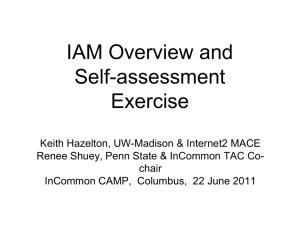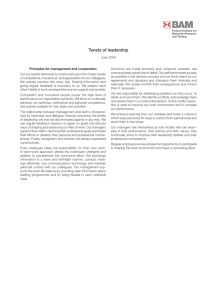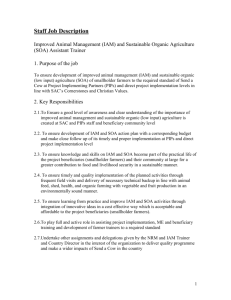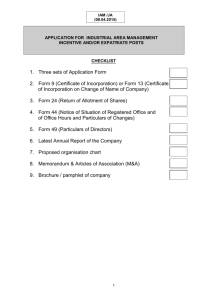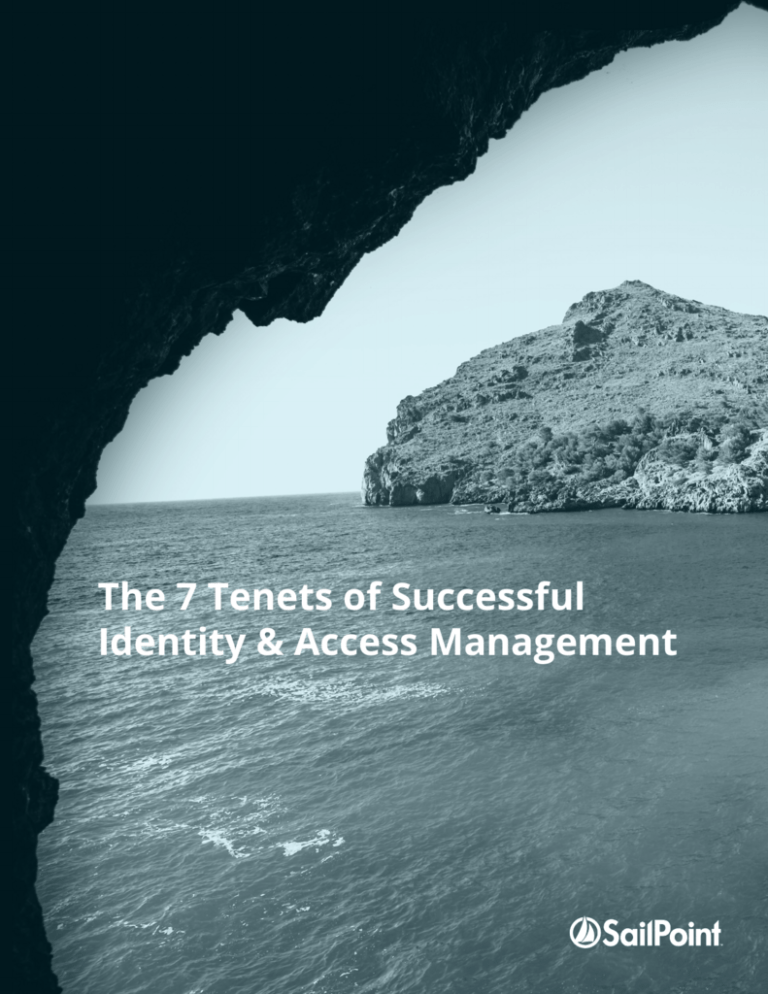
The 7 Tenets of Successful
Identity & Access Management
Data breaches. The outlook is not promising. Headlines practically write themselves
as new breaches are uncovered. From Home Depot to the US Government’s Office of
Personnel Management to Ashley Madison, targeted attacks are on the rise. They have
increased 91% since 2013 which was known as the year of the Mega Breach1.
The total number of breaches themselves have increased 62% since that same time
and the role of insiders in these breaches is significant. According to Verizon’s Data
Breach report, 88% of insider breaches are due to privilege abuse. In fact, according to
SailPoint’s own survey, 1 in 7 employees would be willing to sell their login credentials
for as little as $150.
The insider risk remains. The external and internal risk are real.
1
According to Symantec
1
SailPoint White Paper: The 7 Tenets of Successful Identity & Access Management
The Disappearing Perimeter
The relationship between enterprises and their data is much more complex than ever before.
In a regular workday, the average employee touches a massive number of systems – each with
different levels of privilege demands. A head of HR needs high levels of privilege access to
the HR system but low privilege to the IT infrastructure, product intellectual property or sales
database. Product managers need almost the opposite access. How do you know each only has
access to the level they are authorized?
And while everyone thinks about employees and IT staff access, what about the contractors
and suppliers? And while many may not consider customers as needing access, they leverage
product support, partner portals and all sorts of semiprivileged data. Then there are the ex-employees who still
have their personal phones, computers and data sources they
accessed while still on the inside. Were their access rights
revoked timely?
With all these scenarios and complexity, the notion of network
primary controls
“ The
provided by network
security are just not
enough anymore.
and perimeter is becoming irrelevant. Data is in the cloud and
”
on mobile devices; it is accessed not just by employees but also external parties.
Enterprise security is in need of a new paradigm and evolving from network-centric to identitycentric. The increasingly complex relationships between people and data is redefining perimeter
defenses and making us think about access management in a very different way.
SailPoint White Paper: The 7 Tenets of Successful Identity & Access Management
2
Enterprise Security Has Become
Identity-Centric
Security starts with a subject (an employee or a program) gaining access to a resource (an
application or data file) via access controls. Access controls are the system-level constraints that
make sure that the right people have the right access and the bad guys are kept out. Application
services now support a vast array of internal customers from employees to contractors to partners.
In addition, it is common today to host applications on-premises and in the cloud in true hybrid
environments. Between mobile platforms and data hosted in multiple clouds, system-to-system
data flows are complex.
The Identity Access Management (IAM) job is simple in principle: give the right people the right
access to the right data. To do this, trusted and properly managed identity access has to become
the primary control. It comes down to three basic questions to govern access:
1. Who has access today? This is a question of inventory and compliance. It starts with
understanding the current state. It is about cataloging and understanding access in order
to ensure it is correct.
2. Who should have access? Models and automation are the cornerstones to determining
who should have access. For us to answer the question “should Joe have access to
this file,” we must first know who Joe is. We then have to understand and classify the
data he is attempting to access. We have to establish a model that defines if Joe’s
access conforms to his pre-defined policy. While partitioning data this way may be more
complex, it is critical to implementing any form of preventive controls.
3. Determining “who did have access” is a question of monitoring and audit. It is no longer
enough to understand who does and who should have access. It is vital for IT security
forensics and auditing to surface who was actually granted access, in addition to when
and where it was last used.
DATA
3
ACCESS
RIGHTS
PEOPLE
SailPoint White Paper: The 7 Tenets of Successful Identity & Access Management
Know the Points of Weakness in your IAM
When looking at the post-incident forensic reports from any high-profile data breach, there are
always basic identity and access management errors at the root cause. Simple things like overly
complex data access and unknown data classification are usually a factor. Some others include:
1. Can you tell what files have been stolen? What kind of data inventory do you have to help
you find out?
2. How many separate login systems are you managing between Product, Sales, Ops,
Finance and Support and are they all on-premises or are some hosted in the cloud?
3. Are your data pools in large repositories and how finely have you partitioned access?
4. What is the difference in access level to your employees, contractors, partners and
customers? Are they all accessing the same networks at different levels or do you host
duplicate but separate networks for each?
5. Can you tell the difference between a valid account and a rogue account?
There are obviously many more factors and the identity access questions get complex quickly.
At SailPoint, we have had the privilege to be invited into a wide range of customer environments
and witnessed an even wider range of identity management challenges. We have assembled the
knowledge we gained from these experiences into 7 basic tenets of best practices enterprises
should use when designing and integrating a next generation Identity Access Management
system.
Complex Data
Access
Overentitled
Users
Corporate IT
& Data Assets
Rogue
Accounts
SailPoint White Paper: The 7 Tenets of Successful Identity & Access Management
Privileged
Access
4
The 7 Tenets of
Successful Identity &
Access Management
5
SailPoint White Paper: The 7 Tenets of Successful Identity & Access Management
Consider Everything
1
Identity and access management is no longer a ‘do it yourself’ project. The sheer number of users, data
applications, interfaces and platforms in the modern enterprise requires an integrated IAM system. From
password management across multiple data repository platforms to compliance to role management to
audit, misalign one interface and at best your system will fail. At worst, your identity access system ends up
with a vulnerability that does not surface immediately, but that a cybercriminal might exploit later. A single
integrated IAM platform can coordinate all rules, all compliance and all monitoring into one place ensuring
that nothing is missed.
Patching together an enterprise-level IAM solution by stitching the embedded identity control systems of
multiple SaaS and enterprise software vendors leaves your network open to potential gaps in coverage and
creates fragile links between systems. An integrated enterprise solution will control and monitor all your
users, all your applications, all your data, and all access rights.
Role Management
Password
Management
Compliance
Controls
Identity
Analytics
IAM
Platform
Single
Sign-On
SailPoint White Paper: The 7 Tenets of Successful Identity & Access Management
Data
Governance
Access
Request
6
2
Remember your Customer
The enterprise has to service a
wide range of internal customers
with different data access needs
from different locations using
different access devices. The
IAM solution must be adaptable
across all this. Whether a user
is accessing a sales database
from a hotel in Europe via their
smartphone, an ERP system from
a tablet on a production floor or a
finance system from a desktop at
the corporate headquarters, each
access needs to be authenticated quickly, transparently and accurately.
This includes an internal contractor requesting simple access via single sign-on, a business user adjusting
data ownership rights, a high-level compliance officer monitoring compliance or a road warrior asking for a
password reset behind the corporate firewall. Any user, any platform, any time. In a friendly, easy way.
7
SailPoint White Paper: The 7 Tenets of Successful Identity & Access Management
Be Context Aware
3
Understanding users and, most importantly, the data and resources they should and typically access
is critical. Identity context is about sharing and understanding these relationships and translating them
into entitlements or rights. That context model needs to sit in the center of the security and operations
infrastructure as the identity governance and administration engine. It is a model of known relationships
between people, accounts, privileges and data. For example, when a security event is generated out of a SIEM or DLP system, a context-aware identity
management system can use its knowledge of people, their accounts and the data they are allowed to
access and take remediation actions. If an access request is outside the boundaries of their approved
access levels, a good IAM system may suspend their account or even lock their mobile container.
“
Identity context is about sharing and understanding the
relationship among people, accounts, privilege and data.
SailPoint White Paper: The 7 Tenets of Successful Identity & Access Management
”
8
4
Govern by Model
Managing the access of thousands of users requires governance models. These models are what make
the IAM engine effective. They consist of a set of Automation Models, Role Models, Change Models, Risk
Models, and Control Models. They each drive individual compliance and groupings interactions which as a
group drive common policy.
Models often start in HR and monitor new employees, employee changes and employee terminations.
These are called Joiner/Mover/Leaver events. From there, access models are created for the bulk of users
who operate in self-service modes. In addition, IT security requires models for automation and control to
closely monitor access activity, and the IT audit department needs special compliance and audit actions
that wrap around the core of the enterprise’s data protection strategy.
Placing governance models at the center creates a stable, repeatable and scalable approach to enterprise
identity control.
Role
Models
Policy
Models
IAM
Platform
Risk
Models
9
Entitlement
Models
SailPoint White Paper: The 7 Tenets of Successful Identity & Access Management
Managing Risk is a Verb
5
Managing risk is the mechanism for how you know when an action falls outside of normal usage. Identity
risk scoring can be accomplished by model in an advanced IAM system. Risk scoring allows for faster
access authentication and tracking strategies. For instance, a low risk account may have only read
privileges, no policy violations and no access to high risk data or applications. A high risk profile may
have orphaned accounts, system administrative access to highly sensitive data with lots of privileges, or
has been associated with active policy violations. These accounts may require event-based certification
whenever something changes in their
environments for logins rather than a
simple quarterly review audit.
Low Risk
Medium Risk
High Risk
And in between are accounts
upgraded from low risk or
downgraded from high risk. For
may prompt immediate event-based
certification, restrict their access
request environments or other actions.
In any case, knowing a user’s risk
Magnitude
these, a series of failed login attempts
profile helps in assessing how closely
their online activities need to be
monitored.
Vulnerability
SailPoint White Paper: The 7 Tenets of Successful Identity & Access Management
10
6
Connect to Everything
When considering an integrated IT system such as identity access management, the most difficult decision
an enterprise needs to make is determining how much of an existing platform to keep and how much needs
to be replaced. Some parts of their internal IT architecture will stay the same and so the IAM system needs
to be flexible enough to connect to everything and anything. Effective identity and access management
requires connectivity from any kind of platform to any kind of data repository.
This may mean working with older 3rd party provisioning platforms as well as more recent infrastructure like
Mobile Device Management software managing mobile security or Service Management Platforms that may
still be using manual fulfillment processes.
Accomplishing this requires a direct connector framework with the ability to manage databases, directories
and servers. Also important is the ability to provide out-of-the-box connectors for enterprise applications
like SAP and Oracle Fusion, mainframe security managers, cloud and SaaS apps. Agent-less technology
that makes each connector easier to deploy and maintain over time is key for a successful IAM platform
deployment.
IAM Provisioning
MIM
SIM
PIM
Connector Framework
Mobile Device
Management
Platform
11
Service
Management
Platform
3rd Party
Provisioning
Platform
SailPoint White Paper: The 7 Tenets of Successful Identity & Access Management
Be Consistent
7
This may sound intuitive but consistency in all these actions and approaches is key. The business user
wants access regardless of where the apps are served. The auditor only cares about compliance, not
where data is stored. The IAM solution needs to bridge gaps like these seamlessly and consistently to
secure the business in a scalable way.
Regardless of where the data resides, one-off connections or patched provisioning should be excluded
from the IAM implementation design, otherwise scalability will be impacted whether data is structured or
unstructured.
Structured
Data
Cloud / SaaS / Mobile
Unstructured
Data
Enterprise / On-prem
SailPoint White Paper: The 7 Tenets of Successful Identity & Access Management
12
Summary
The modern enterprise is more complex than ever and identity and access management is at its
core. While it is possible for enterprises to piece together their own solutions, the number of rules,
number of best practices, and number of intricacies involved with implementing a secure IAM
solution is huge. There is a lot at stake. It only takes one misconfiguration to open your enterprise
to anyone wanting in.
Only SailPoint offers all these 7 tenets in one solution. Since our inception, SailPoint has been
integrating complex IAM solutions for a wide range of customers in a wide range of markets.
SailPoint is the IAM market leader and has been a Gartner Magic Quadrant market leader for
several years with over 500 customers around the world. We are innovators in the area of identity
and access management and have helped a lot of customers navigate through exactly the
obstacles we have shared in the 7 tenets.
We understand business users, business complexities and most of all, we understand what is at
stake when it comes to accurate identity monitoring and compliance. You spent your life’s work on
your business. We have done the same in identity and access management. We have refined the
mechanisms for fast and effective IAM strategy and are ready to share our vision, solutions and
knowledge with your organization.
Visit SailPoint.com for more information and to schedule a demonstration.
13
SailPoint White Paper: The 7 Tenets of Successful Identity & Access Management
About SailPoint
Corporate Headquarters
11305 Four Points Drive
Building 2, Suite 100
Austin, Texas 78726
512.346.2000
USA toll-free 888.472.4578
www.sailpoint.com
As the fastest-growing, independent identity and access management (IAM) provider, SailPoint helps hundreds
of global organizations securely and effectively deliver and manage user access from any device to data and
applications residing in the datacenter on mobile devices and in the cloud. The company’s innovative product
portfolio offers customers an integrated set of core services including identity governance, provisioning and
access management delivered on-premises or from the cloud (IAM-as-a-service). For more information, visit
www.sailpoint.com.
© 2015 SailPoint Technologies, Inc. All rights reserved. SailPoint, the SailPoint logo and all techniques are trademarks or registered trademarks
of SailPoint Technologies, Inc. in the U.S. and/or other countries. All other products or services are trademarks of their respective companies.

